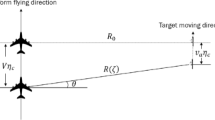Abstract
It appears very interesting and particularly useful to perform DEM reconstruction with the configuration of multichannel bistatic SAR (BiSAR) because of its considerable advantages. In typical processing flow of multichannel interferometric synthetic aperture radar (InSAR), techniques based on statistical methods or iterative methods does not work very well with limits of specific BiSAR configurations. Moreover, the tradeoff between the correctness and precision of the reconstruction of different baselines needs to be overcome as well. Based on the advantages of multichannel BiSAR configuration, basic idea is the joint utilization of amplitude data, iterative reconstruction results and ML results to help the optimization of the total MRF energy function. Thus, a multichannel DEM reconstruction method based on Markov Random Fields (MRFs) for BiSAR, which concerns much about discontinuities and energy functions, is proposed to achieve not only correct but also more precise results. Afterward, the strategy to determine the weight parameter and processing flow is presented. Finally, simulated and real data experiments are given to validate the proposed method.
Similar content being viewed by others
References
Loffeld O, Nies H, Peters V, et al. Models and useful relations for bistatic SAR processing. IEEE Trans Geosci Remote Sens, 2004, 42: 2031–2038
Krieger G, Moreira A, Spaceborne bi- and multistatic SAR: potential and challenges. IEE Proc-Radar Sonar Navig, 2006, 153: 184–198
Nies H, Behner F, Reuter S, et al. Polarimetric and interferometric applications in a bistatic hybrid SAR mode using Terrasar-X. In: Proceedings of Geoscience and Remote Sensing Symposium (IGARSS), Hawaii, 2010. 110–113
Duque S, López-Dekker P, Merlano J C, et al. Bistatic SAR along track interferometry with multiple fixed receivers. In: Proceedings of Geoscience and Remote Sensing Symposium (IGARSS), Hawaii, 2010. 4099–4102
Duque S, López-Dekker P, Mallorqui J J, et al. Experimental results with bistatic SAR tomography. In: Proceedings of Geoscience and Remote Sensing Symposium (IGARSS), Cape TOWN, 2009. II-37-II-40
Wang R, Deng Y, Zhang Z, et al. Double-channel bistatic SAR system with spaceborne illuminator for 2-D and 3-D SAR remote sensing. IEEE Trans Geosci Remote Sens, 2013, 51: 4496–4507
Walterscheid I, Espeter T, Brenner A R, et al. Bistatic SAR experiments with PAMIR and TerraSAR-X-setup, processing, and image results. IEEE Trans Geosci Remote Sens, 2010, 48: 3268–3279
Bamler R, Hartl P. Synthetic aperture radar interferometry. Inverse Probl, 1998, 14: R1–R54
Ghiglia D C, Pritt M D. Two-dimensional Phase Unwrapping: Theory, Algorithms, and Software. New York: Wiley, 1998
Ferraiuolo G, Meglio F, Pascazio V, et al. DEM reconstruction accuracy in multichannel SAR interferometry. IEEE Trans Geosci Remote Sens, 2009, 47: 191–201
Pascazio V, Schirinzi G. Estimation of terrain elevation by multifrequency interferometric wide band SAR data. IEEE Signal Process Lett, 2001, 8: 7–9
Ferretti A, Prati C, Rocca F. Multibaseline InSAR DEM reconstruction: the wavelet approach. IEEE Trans Geosci Remote Sens, 1999, 37: 705–715
Thompson D G, Robertson A E, Arnold D V, et al. Multi-baseline interferometric SAR for iterative height estimation. In: Proceedings of Geoscience and Remote Sensing Symposium (IGARSS), Hamburg, 1999. 251–253
Pascazio V, Schirinzi G. Multifrequency InSAR height reconstruction through maximum likelihood estimation of local planes parameters. IEEE Trans Image Process, 2002, 11: 1478–1489
Fornaro G, Monti Guarnieri A, Pauciullo A, et al. Maximum likelihood multi-baseline SAR interferometry. IEE Proc-Radar Sonar Navig, 2006, 153: 279–288
Ferraiuolo G, Pascazio V, Schirinzi G. Maximum a posteriori estimation of height profiles in InSAR imaging. IEEE Trans Geosci Remote Sens, 2004, 1: 66–70
Eineder M, Adam N. A maximum-likelihood estimator to simultaneously unwrap, geocode, and fuse SAR interferograms from different viewing geometries into one digital elevation model. IEEE Trans Geosci Remote Sens, 2005, 43: 24–36
Yuan Z H, Deng Y K, Li F. Multichannel InSAR DEM reconstruction through improved closed-form robust Chinese remainder theorem. IEEE Geosci Remote Sens Let, 2013, 10: 1314–1318
Ferraioli G, Ferraiuolo G, Pascazio V. Phase-offset estimation in multichannel SAR interferometry. IEEE Geosci Remote Sens Lett, 2008, 5: 458–462
Ferraioli G, Shabou A, Tupin F, et al. Multichannel phase unwrapping with graph-cuts. IEEE Geosci Remote Sens Lett, 2009, 6: 562–566
Shabou A, Baselice F, Ferraioli G. Urban digital elevation model reconstruction using very high resolution multichannel InSAR data. IEEE Trans Geosci Remote Sens, 2012, 50: 4748–4758
Chen R P, Yu W D, Wang R, et al. Integrated denoising and unwrapping of InSAR phase based on Markov random fields. IEEE Trans Geosci Remote Sens, 2013, 51: 4473–4485
Denis L, Tupin L, Darbon J, et al. SAR image regularization with fast approximate discrete minimization. IEEE Trans Image Process, 2009, 18: 1588–1600
Shao Y, Wang R, Deng Y K, et al. Error analysis of bistatic SAR imaging and stereoscopy bistatic SAR. IEEE Trans Geosci Remote Sens, 2013, 51: 4518–4543
Wang R, Loffeld O, Neo Y L, et al. Focusing bistatic SAR data in airborne/stationary configuration. IEEE Trans Geosci Remote Sens, 2010, 48: 452–465
Wang R, Loffeld O, Nies H, et al. Frequency-domain bistatic SAR processing for spaceborne/airborne configuration. IEEE Trans Aero Elect Syst, 2010, 46: 1329–1345
Li S Z. Markov Random Field Modeling in Image Analysis. New York: Springer-Verlag, 2009. 126–129
Author information
Authors and Affiliations
Corresponding author
Rights and permissions
About this article
Cite this article
Hong, F., Tang, J. & Lu, P. Multichannel DEM reconstruction method based on Markov random fields for bistatic SAR. Sci. China Inf. Sci. 58, 1–14 (2015). https://doi.org/10.1007/s11432-015-5320-z
Received:
Accepted:
Published:
Issue Date:
DOI: https://doi.org/10.1007/s11432-015-5320-z




